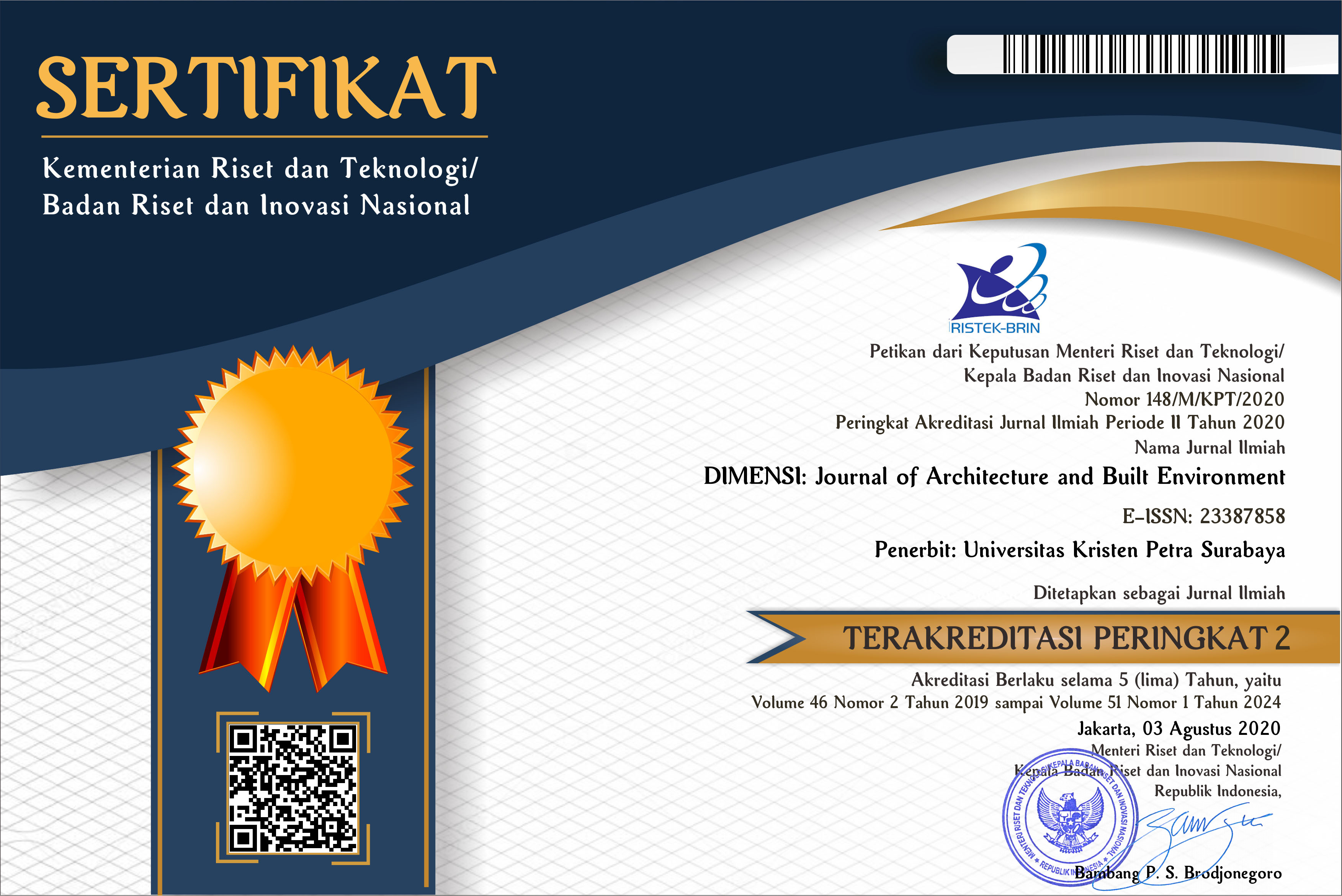SITE BARRIER OPTIMIZATION ON INTEGRATING THERMAL COMFORT WITH NOISE PROPAGATION CONTROL
 :
:
https://doi.org/10.9744/dimensi.44.1.45-52
Keywords:
Noise control, site barrier, thermal comfort.Abstract
The difference in geographical altitudes in tropical environment not only causes variations in climate and environment leading to influences on thermal comfort, but also effects on noise propagation variation. This study proposes the site barrier optimization and integrated control on thermal performance and environmental noise to reach the standards using ANSYS Fluent and MATLAB simulations method. The research locations are in Surabaya as the lowland area and Malang as highland area, all are representatives of tropical urban environment of Indonesia. The results highlighted that the minimum barrier distance to receiver for the lowest barrier height (1.5 m) for both thermal and noise improvement is 5.63 m. Meanwhile, at minimum distance for noise control (1.8 m), the minimum reference height of aperture is 1.02 m when it uses lowest barrier height.
Downloads
References
Aynsley, R.M., Melbourne, W. & Vickery, B.J. (1977). Architectural Aerodynamics. Applied Science, London.
Aynsley, R.M. & Spruill, M. (1990). Thermal comfort models for outdoor thermal comfort in warm humid climates and probabilities of low wind speeds. Journal of Wind Engineering and Industrial Aerodynamics, 36, pp. 481-488.
Berglund, B., Lindvall T., Schwela D. & Goh, K.T. (2000). Guidelines for Community Noise. Geneva: World Health Organization (WHO).
Boutet, T.S. (1987). Controlling air movement: A manual for architects and builders. McGraw Hill, USA.
Construction and Building, Department of Public Work (Pd T-16-2005-B). Mitigation of Impacts Due to Road Traffic Noise.
Ghiaus, C., Allard, F., Santamouris, M., Georgakis, C. & Nicol, F. (2006). Urban environment influence on natural ventilation potential. Building and Environment, 41, pp. 395-406.
Huang, L., Zhu Y., Ouyang, Q. & Cao, B. (2012). A study on the effects of thermal, luminous, and acoustic environments on indoor environmental comfort in offices. Building and Environment, 49, pp. 304-309.
Lai, A.C.K., Mui, K.W., Wong, L.T. & Law, L.Y. (2009). An evaluation model for indoor environmental quality (IEQ) acceptance in residential buildings. Energy and Buildings, 41, pp. 930-936.
Sakamoto, S. (2015). Road traffic noise prediction model ‘‘ASJ RTN-Model 2013’’: Report of the research committee on road traffic noise. Acoust. Sci. & Tech, 36(2), pp. 49-108.
Samodra, F.X.T.B.S., Yum, S.K. & Yoon, S.H. (2014). Experimental study on thermal and noise environment in Indonesian Javanese houses. International Conference on The Yellow Sea Rim International Exchange Meeting on Building Environment and Energy (YSRIM 2014), Busan, Korea, February 16-18, pp. 60-67.
Samodra, F.X.T.B.S. (2015). Environmental Psychology Survey on Traditional Building Occupant in Tropical Environment. International Seminar of Indonesian Students Association in Korea, Daejeon, Korea, September 5-6.
Yamamoto, K. (2010). Road traffic noise prediction model ‘‘ASJ RTN-Model 2008’’: Report of the research committee on road traffic noise. Acoust. Sci. & Tech, 31(1), pp. 2-55.
Downloads
Published
How to Cite
Issue
Section
License
Authors who publish with this journal agree to the following terms:
- Authors retain copyright and grant the journal right of first publication with the work simultaneously licensed under a Creative Commons Attribution License that allows others to share the work with an acknowledgement of the work's authorship and initial publication in this journal.
- Authors are able to enter into separate, additional contractual arrangements for the non-exclusive distribution of the journal's published version of the work (e.g., post it to an institutional repository or publish it in a book), with an acknowledgement of its initial publication in this journal.
- Authors are permitted and encouraged to post their work online (e.g., in institutional repositories or on their website) prior to and during the submission process, as it can lead to productive exchanges, as well as earlier and greater citation of published work (See The Effect of Open Access).


















